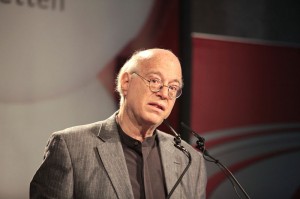New Ways of Thinking About Space

Richard Sennett, at the Linz Lectures, 2010. Photo by rubra, Ars Electronica (Austria). CC-BY-SA 2.0.
Along with David Graeber, Richard Sennet–social and cultural theorist and proud son and nephew of veterans of the Lincoln Brigade–has an article in this week’s issue of The Nation dedicated to the anniversary of Occupy Wall Street:
It’s been a year since the Occupy movements of 2011, and like other participants, I’ve been thinking about their legacy. In Spain, Greece, Britain and the United States, relatively small numbers of protesters made a big noise about the evils of capitalism; to me, though, the movement’s lasting gift was embodied in the very word “occupy.” The protests occurred in spaces where they did not belong, taking place in plazas (New York), on church steps (London) or in commercial squares (Madrid), where protesters had no right to assemble. The Occupy movements dramatized questions about public space—who owns it? who can use it?—and provided some surprising answers. …
What will the legacy of the Occupy movements be? It’s become a commonplace to lump them together with the wave of protests in 2011 along the Mediterranean rim of Africa—something that only confuses the achievements of both groups. In Libya and Egypt, masses of people were locked in mortal combat against tyrants, whereas the Occupiers were a relatively small group who changed the terms of debate about the current economic crisis. In the process, they also challenged urbanists like me to think about the city in new ways.
Read the whole article here; a 2001 interview with Sennet in the Guardian is here.












